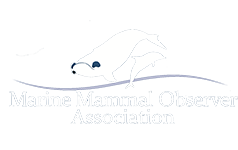The Marine Mammal Observer Association (MMOA) considers that the production of a comprehensive and informative Environmental Impact Assessment (EIA) and the subsequent development of a site-specific, detailed Mitigation Plan (MP) for Species of Concern (SoC) are fundamental to effective mitigation programmes. It is important that these documents are produced well in advance of a mitigation survey and that both documents are made available to the mitigation team before or at the start of a survey so that the processes involved in developing the MP are clearly understood by the Marine Mammal Observers (MMOs)/Passive Acoustic Monitoring (PAM) Operators. Some key points are outlined below.
Environmental Impact Assessment (EIA)
In the context of this document, the purpose of an EIA is to identify, predict and evaluate the effects of anthropogenic sound on SoC prior to, and during, a survey using a sound source and identify mitigation measures to address these. Some regulators provide specific guidance for the development of EIAs relating to the potential environmental impacts of seismic surveys and the use of other anthropogenic sound sources (such as piling, geophysical and geotechnical site survey and explosives). The MMOA considers that the EIA content with respect to SoC and anthropogenic sound should include the following (as a minimum):
- Information on the potential and confirmed occurrence of SoC within the project area. This information should originate from comprehensive literature reviews of peerreviewed scientific papers whenever possible. However, the MMOA recognises that published scientific information is lacking for many marine regions. In its absence, consideration should be given to additional supporting information; such as reports and datasets that may highlight species presence in an area. This should include information on species presence, density, seasonal and spatial distribution, breeding periods and behaviour, where these are available. Any species of particular sensitivity should be identified, for example through assessments of SoC global and regional conservation status (such as IUCN status), local protective legislation to identify locally-important conservation priorities, and compiled information on breeding, feeding or migratory habitat which may indicate the presence of critical habitats for SoC. Where existing information on species occurrence within a project area is scarce, the establishment of baseline characterisation surveys should be considered to provide initial information on SoC occurrence on which a mitigation plan can be based and subsequent impacts identified. Given the marked seasonal variation in occurrence of many SoC within particular areas, any baseline characterisation surveys carried out should occur at the same time of year as the planned use of the anthropogenic sound source.
- Details of any environmental legislation pertinent to the protection of SoC in the project area and its implications for the mitigation programme.
- Characteristics of the source being used during the survey. These should include equipment types, amplitude (sound level) and pressure, frequency characteristics and pulse duration. Duration of noise-generating activities and repetition rates for impulsive sources should be provided to allow characterisation of total acoustic emissions to which animals would be exposed.
- An assessment of transmission loss around the sound source. This is commonly modelled as simple geometric spreading, either spherical (intensity falls off with distance squared) or cylindrical (intensity falls linearly with distance). However, these methods are oversimplified in the case of loud sound sources in deeper waters, or depending on specific oceanographic conditions within a project area that often lead to substantial variability of transmission loss across different frequency bands. Consequently, the MMOA considers that transmission loss modelling should always be site-specific and should take into account the local topography and oceanographyof the project area at the time of the survey and also the geoacoustic nature of the seabed sediments and bedrock. In the absence of site-specific data it is recommended that databases such as the World Ocean Atlas for oceanography and ETOPO1 (NOAA) or Shuttle Radar Topography Mission (SRTM) for bathymetry, and the British
Geological Survey (BGS) charts in UK waters for sediment and bedrock information be investigated for modelling purposes. For these reasons more sophisticated modelling techniques to those listed above should be carried out by suitably experienced (or expert) acoustic modellers. The correct model, or combinations of, should be used to cover the range and frequency of the source, for example, short range/high frequency sources require different models to long range/low frequency sources. - Identification of, and predictions regarding, the potential impacts of the sound source on the SoC that occur in the area (bearing in mind that this will likely require separate evaluation for particular species groups, for example mysticetes, odontocetes, pinnipeds, sea turtles etc.), via a thorough literature review that includes consideration of specific hearing sensitivities. With regard to anthropogenic sound, consideration should be given to:
-
- The potential impacts of anthropogenic sound on the SoC occurring within the survey area. This should include both direct (e.g. tissue damage, hearing loss) and indirect (e.g. displacement of SoC or their prey species) impacts.
- The sound levels documented to cause hearing loss and other impacts in the specific SoC found within the survey area.
- The current ‘safe sound levels’ (i.e. sound levels below which exposure is unlikely to result in disturbance or injurious impacts) documented for SoC.
- Calculations of the radius of these safe levels around the proposed sound source (taking into account actual/expected sound transmission properties within the specific survey area and pulse emission rate). Also to be included should be a discussion of how the size of a given impact zone may change as a result of propagation in one direction or another. For instance, the beam
pattern of a sound source combined with propagation over the local bathymetry might result in the distance over which an impact may occur being somewhat shorter in one direction than another. - Conclusions on the likely impacts on individual animals and at the population level (especially considering feeding, breeding and migratory areas), based on sound exposure and overall duration of the survey.
- An assessment of cumulative impacts where more than one operation is active simultaneously or activity is over a long period of time. For example, some piling construction projects may last for 2-3 years. It should also be noted that an assessment of cumulative impacts is a requirement under some countries’ EIA regulations.
- A review, identification and evaluation of other potential impacts of the survey work on SoC within the survey area, for example vessel strikes, pollution and entanglement in seismic gear.
Information on how the potential impacts on SoC identified during the EIA will be mitigated during the survey. This may take the form of a Mitigation Plan (MP) for specific high-risk impacts (e.g. a MP for sound source mitigation as described below) and additional statements regarding other impacts (e.g. the use of ‘turtle guards’ on seismic tail buoys to mitigate against sea turtle entrapment).
All relevant documentation should be made available to personnel implementing the mitigation plans.
Mitigation Plans (MPs) for anthropogenic sound sources
The MP should provide the specific details of how particular impacts on SoC identified during the EIA will be mitigated during the survey. The MMOA considers that a MP should be:
- Detailed, providing unambiguous instruction on the procedures to be followed under the various circumstances that may arise during a survey (flow charts of mitigation actions are often beneficial).
- Clear and using correct, consistent and well-defined terminology throughout, to avoid any misinterpretation.
- Produced by, and reviewed by, personnel who have sufficient expertise (indicated by qualifications and previous experience with marine fauna mitigation) to make these assessments and decisions.
Due to their first-hand experience in the practicalities of implementing MPs during surveys, the MMOA recommends that experienced MMOs/PAM Operators are shown the MP prior to a project in order to highlight any discrepancy or areas that need further clarification. The MP agreed prior to the survey should be followed rigorously as a minimum standard throughout the survey and should not be subject to changes once a survey has commenced. The only exceptions should be when ambiguities in the protocols require clarification, or when additional mitigation measures are added based on unexpected faunal encounters. These changes must be approved by the relevant authority or regulator.
The information below relates specifically to MPs which aim to mitigate the impacts from an anthropogenic sound source on SoC. Some regional regulators have existing mitigation procedures that must be adopted as a legal requirement during surveys in their waters, and those procedures should always be followed when developing a MP. The MP should clearly describe the recommended suite of mitigation measures to be implemented by the mitigation team, in order to minimise the potential impacts of the sound source on the SoC that were identified during the EIA. This should include the following (as a minimum):
- Establishment of a mitigation zone (MZ) around the sound source.
- Procedures for the monitoring of SoC within the MZ prior to and during operations.
- The importance of hiring suitably qualified MMOs and PAM Operators.
- Use of appropriate real-time mitigation measures should a SoC be detected inside the MZ prior to and during source operations. This should also include a list of SoC for which mitigation measures will apply.
- The incorporation of additional mitigation measures to minimise the likelihood that undetected SoC are exposed to injurious levels of source activity (e.g. due to night, poor weather or the limitations of monitoring techniques). This should include a detailed outline of source start-up procedures as well as clarification on what procedures should be followed after any breaks in source activity. In the case of seismic airgun arrays this should include information on whether the system will be automated or manually-operated, details of the order in which each gun of specified volume/sound level will be added-in and a graph showing cumulative volume/sound level of the array over time. This should expressly include procedures for the inclusion of ‘spare guns’ in the soft start without exceeding the normal operational volume during production and procedures for soft starts during gun tests.
- Procedures to ensure that the amount of source activity is minimised as much as possible during operations.
- Information on the communication links (and chain of command) between the
mitigation team and the operators of the sound source, in order to ensure quick and well-implemented mitigation actions when animals are observed. - Procedures for recording and reporting compliance to appropriate regulatory bodies.
- Documentation that is carefully worded to ensure that it is interpreted as mandatory rather than optional

